Dalotia coriaria
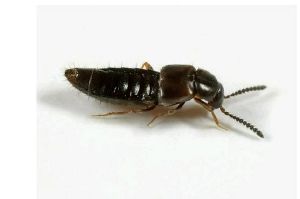
Atheta coriaria, also known as Dalotia coriaria, is a predator of two common greenhouse pests :
These two pests cause aesthetic problems as well as a probable loss of yield and quality. They can cause direct damage to plants as a result of feeding bites, but can also cause significant indirect damage by transmitting pathogens(fungi and viruses) to plants.
-
Symptômes causés par les thrips.
-
Comparaison entre la taille des thrips et du prédateur Atheta coriaria
There is a biocontrol solution for combating these insects. It involves periodically releasing natural enemies, otherwise known as biocontrol agents, onto the crop. These natural enemies can be parasitoids which lay their eggs in the pest, or simple predators. These releases help to reduce and control the population of harmful insects. A beetle known asAtheta coriaria is one of the predators of these two pests. It is authorised in France and can be used in glasshouses.
Performance and effectiveness
Damage caused by pests
Thrips
Thrips are major agricultural pests. They are abundant in fields and particularly in glasshouses. They cause significant economic damage. This is due to the extensive damage they cause, but also to the lack of alternatives to pesticides. They cause damage by feeding on plants and laying eggs on leaves, flowers and fruit. They also act as transmitters of viruses, such as the tomato wilt virus.
-
Piqûres de thrips sur feuilles de tomate.
-
Thrips.
Thrips complete their life cycle between 9 and 13 days. The cycle consists of the laying of an egg, two larval stages, two pupal stages and an adult stage. The eggs hatch in 2 to 4 days, the first instar larvae begin feeding immediately, then the second instar larvae, which are more active in feeding, appear in 2 to 4 days, after which they move into the soil or leaf litter to pupate. The pupal stage lasts around 6 days and is highly tolerant of most insecticides, after which the winged adults emerge. Biological characteristics such as its small size, wide range of host plants and haploid and diploid reproductive systems make this insect very difficult to control.
In addition, the eggs are laid in hidden places, as are the pupal stages, which protects them from insecticides and makes them difficult to spot.
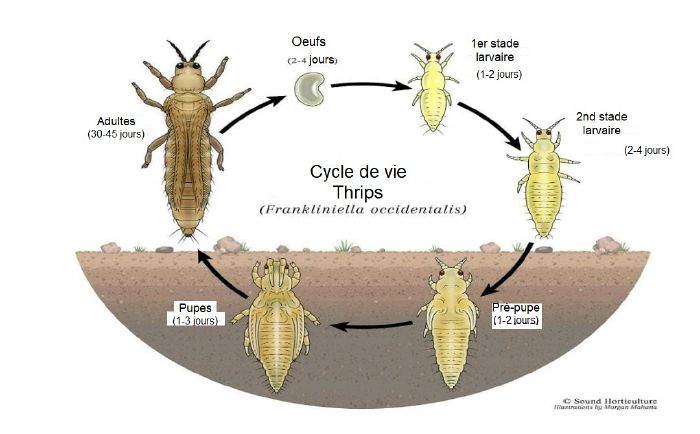
Fungal midges
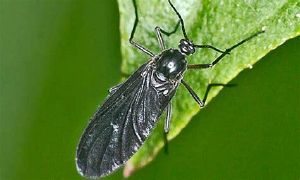
Fungus gnats are 2 to 8 mm long and dark in colour. They are able to fly despite the fact that they are not particularly good fliers. They generally walk quickly through the substrate. The midge larva feeds on plant roots. It causes damage to the roots, which then affects plant growth. The wounds caused by the feeding of these midges also provide an entry point for plant pathogens.
In addition, as adults, midges carry pathogens and spread them throughout the crop. As mentioned above, the wounds caused by the larvae allow the pest to penetrate further into the plant. This can lead to damping-off, root rot, crown rot and stem diseases.
Atheta coriaria as a biocontrol agent
Dalotia coriaria is a species of coleopteraninsect in the Staphylinidae family. This predatory beetle is used as a biological control agent against soil midges (genera Bradysia and Corynoptera).{{Mark as extracted from Wikipedia | page = Dalotia coriaria}}

It occurs naturally in Europe, North Asia, North America and Oceania. This beetle recently changed its name, making it difficult to find information about it. Its new name is : Dalotia coriaria. You can find and buy them under both names. In the remainder of this article, we will refer to it as Atheta coriaria to simplify reading.
Description
- Adults are shiny, dark brown, covered with a thick cuticle and about 3 to 4 mm long. They have short wings (less than the length of their body), and are able to fly long distances even though they generally spend their time in culture media. They generally fly at night. After emerging from the chrysalis, the adults are mobile and search for food.
- The larvae are long and yellow. They have six legs and short antennae, which distinguishes them from other vermiform organisms present in the substrate. They are generalist predators of soil-dwelling organisms. All their life stages take place in or on the growing medium of the crop.
- The beetle is very active, and all the larval stages as well as the adult are predators.
Life cycle
- The development time from egg to adult is 17 days, although this varies according to temperature. For example, the development time from egg to adult is 21 to 22 days at 25˚C and 11 to 12 days at 30˚C.
- Females lay an average of 90 eggs, of which around 70 survive to adulthood.
- The beetle has a wide range of prey, but from a greenhouse perspective the most important prey are fungus gnats, thrips and shore flies. Adults eat an average of10 to 20 prey items a day.
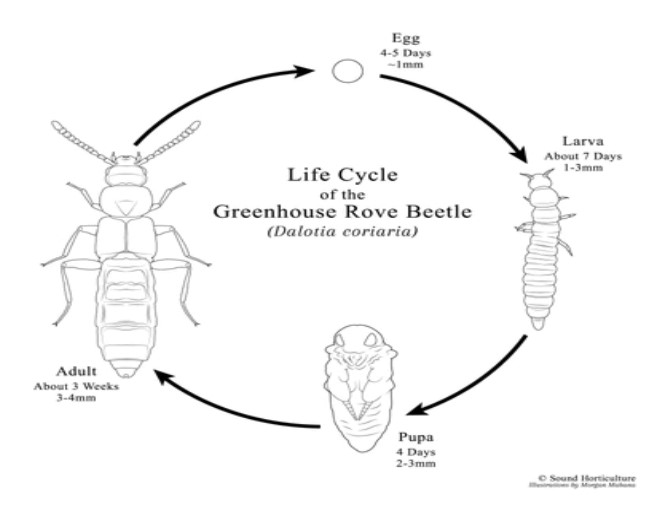
Technical and operational criteria : use, mode of action
Target crops
This biocontrol agent is most effective under glass or under cover, but it is also used in gardens.
Atheta coriaria can adapt to different types of environment :
- Potting soil.
- Coconut fibre.
- Glass wool.
Packaging
Atheta coriaria is generally packaged in cardboard tubes or bulk bags in quantities of 100 to 3,000 insects. They are generally found in the form of a mixture of adults and larvae. The insects are very active and can easily be seen running over the substrate when the product arrives.
The product can be received in a cardboard box or directly in a bucket with holes, ready for use.
Propagation
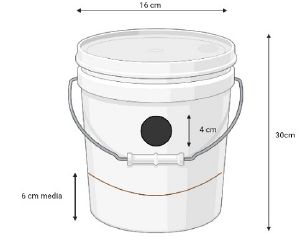
The insects must be placed in a bucket with holes filled with a moist substrate that will allow them to develop and survive, and the holes allow aeration of the medium and the beetles to emerge to find food and spread throughout the crop in due course. Here's an example of a bucket for Atheta coriaria.
Atheta coriaria beetles are able to fly, which allows them to spread evenly throughout the greenhouse on their own.
Depending on the number of beetles released, the treatment can be preventive, curative or maintenance.
Cool temperatures will slow down their activity, but they won't be killed even by intense cold - they survive by burrowing deeper into the soil.
Effectiveness and compatibility with other products
It can be combined with biological insecticides :
- Affects several targets at the same time (broad spectrum) and is therefore more effective.
- Reduces the chances of resistance or adaptation by target organisms.
- Biological activities caused by plants include : behavioural and feeding deterrence, fumigant toxicity, neutralising activity and lethal toxicity. In some cases, they have no direct negative effect on beneficial insects, making them safe for integrated pest management.
The use ofAtheta coriaria :
- Increases the mortality rate of thrips at the pupal stage by 30% compared with no treatment.
- Increases the efficacy of biocontrol products by more than 10 to 20% when their use is combined. [1]
It can be combined with :
- Biocontrol agents targeting foliar thrips :
- Cultivation practices such as : window screens, UV-reflecting mulch, irrigation, flowering chrysanthemums as trap plants.
- Semiochemicals, which are compounds that trigger behavioural, physiological and biochemical changes in other organisms by transmitting chemical signals.
- Theaggregation pheromone ((S)-2-methyl neryl butanoate), which attracts both males and females, has been useful for trapping thrips with sticky traps.
- The alarm pheromone (dodecyl acetate) increased the efficacy of maldison in thrips larval mortality and it can be concluded that pheromones can be explored in the context of integrated pest management.
Crop monitoring
To be sure that Atheta coriaria are present in your glasshouse, you can observe whether adults are present on the walls. Yellow sticky traps can also catch flying adults if the population is really high.
Larvae and adults can also be observed on the ground.
Potato slices, which are sometimes used to monitor populations of potato maggot larvae in the soil (by laying them on the middle and inspecting the underside for potato maggot larvae 24-48 hours later) can also provide information on levels of Atheta presence. It is not known whether Atheta are attracted to the potato itself or to midge larvae feeding on the potato. Sprinkling the underside of the potato slice with ground fish food may enhance the attraction.
It is important to monitor the economic threshold by checking the thrips population using yellow sticky traps, in order to decide which predator-prey ratio to use (1:5, 1:10, 1:15).
Cost
On average, 500 traps cost around €95. For good efficiency, it is recommended to have 7000 individuals per hectare, at a cost of €1330/ha.
Disadvantages
- An overpopulation ofAtheta coriaria can lead to them climbing up plants and sticking to flower buds. This is why application conditions must be respected.
- Intra-group predation will disrupt population dynamics in the ecosystem.
- Plants are more attractive to thrips at the flowering stage than traps, which is why results on sticky cards may be lower and false.
Where can I buy it?
You can find this product at most companies selling biocontrol agents. Here is a non-exhaustive list of sellers :
Advantages and limitations
Atheta can be combined with other biocontrol products.
Atheta increases thrips mortality by 30%.
Intra-guild predation may occur in the event of overpopulation.
Effectiveness slowed by cold.
- ↑ Compatibility of soil-dwelling predators and microbial agents and their efficacy in controlling soil-dwelling stages of western flower thrips Frankliniella occidentalis - Taro Saito , Michael Brownbridge